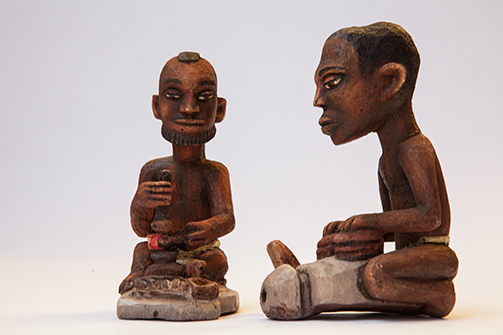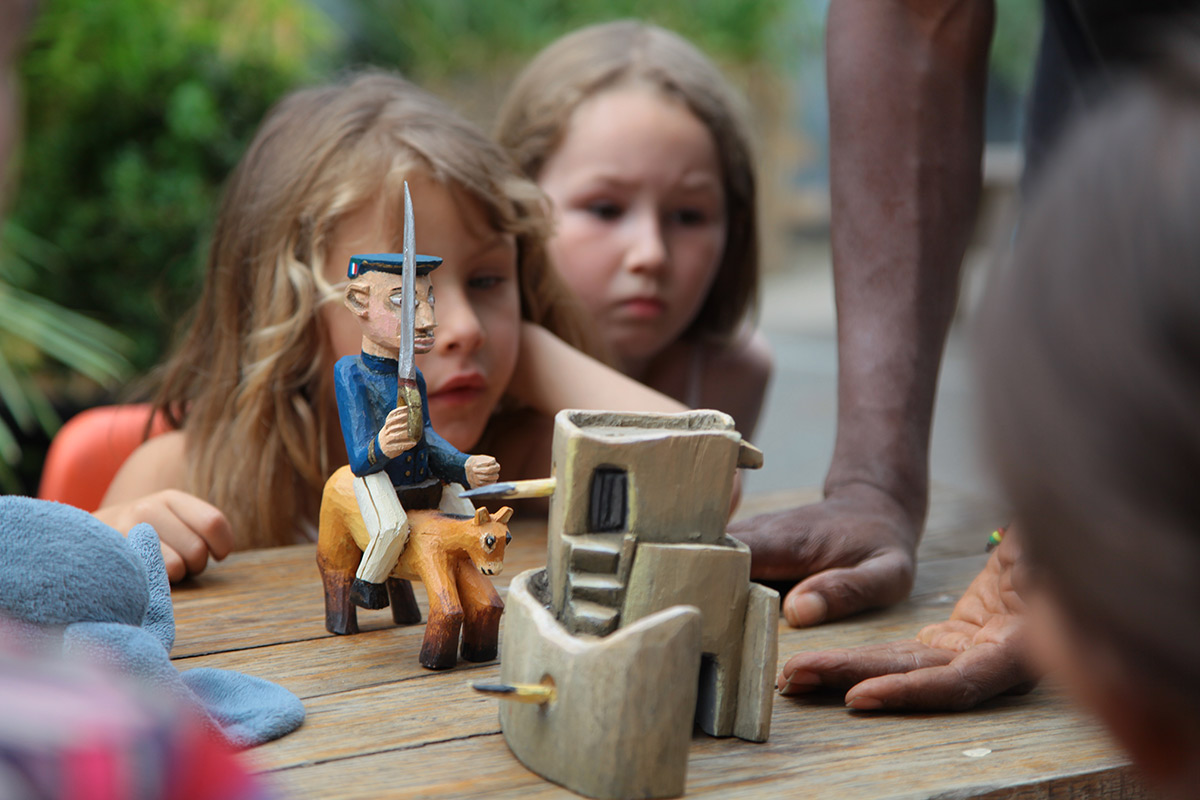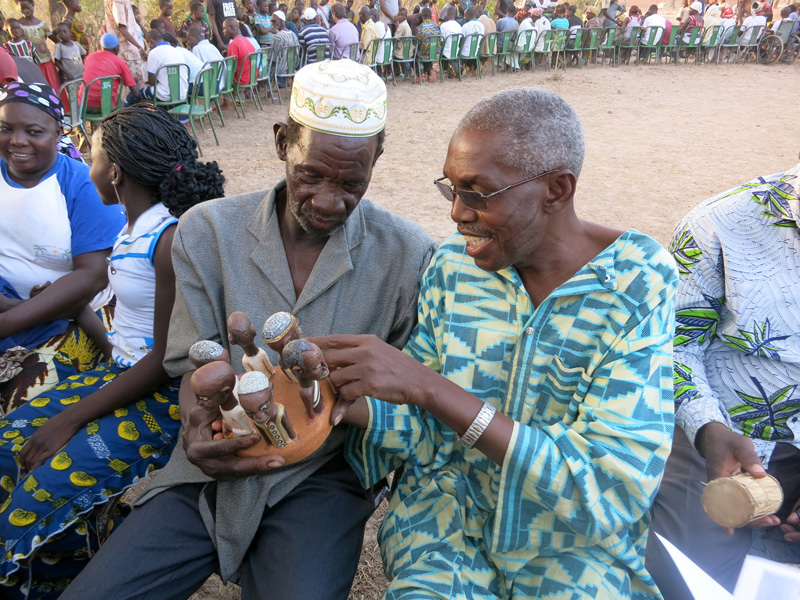Shows > Bona Kélé
Bona Kélé
All the versions of this article: [English] [français]

Bona Kele means the Bona War: that is what many Burkinabé call the rebellion of the people of the Volta Loop against the French colonial authority, in 1915, when it was raising troops for the Great War.
Although the conflict was brutal and massive, it remains little known. This performance with simple, lightweight objects, was produced in collaboration with Les Grandes Personnes of Boromo, written, created, sculpted and staged in Burkina Faso. A succession of 53 evocative objects – wooden sculptures, forged items – help to tell this story.
To learn more
A century ago
In 1987, the sculptor Bomave Konate, who was to be awarded the title “living human treasure” by its country, Burkina Faso in 2016, took me to the little town of Sibi quite dynamic at the time because it had its own train station on the line from Ouaga to Abidjan. There was in the city center, by the road, a very large kapok tree where, he told me, men were hanged in 1916 during the Bwa Insurrection. I often thought about it. If African writers such as Hampate Ba or Nazi Boni mentioned it, in France this important uprising against forced conscription of the Tirailleurs seemed to have been utterly forgotten.
Our regular collaboration and strong ties with artists and inhabitants of this African region, our long lasting partnership with NGO Les Grandes Personnes d’Afrique, marionnettes de Boromo allowed us to rethink this part of our common history, to collect fragments of it and to create an object theater performance.
Christophe Evette
In Burkina Faso
Bona Kele was written, created, staged in Burkina Faso in the towns of Ouri, Ouaga-Dougou and Boromo. This visual theater piece, simple and nomadic is the result of a partnership between the Grandes Personnes d’Aubervilliers et the Grandes Personnes de Boromo, with the help of Burkina Street Theater festival “Rendez-vous chez nous”. Working in Burkina Faso allowed to visit the places where the war took place and to collect the stories still told by children and grand-children of the insurgents.
A nomadic Franco-Burkinabe creation
_The performance comprises 53 objects chosen for their mnemonic capacities, painted wooden sculptures, metal sculptures made by traditional blacksmiths. These elements fit in a hand, they are intimate and accessible supports helping to remember. Each one is linked to a moment in the narrative and resuscitates a fragment of this past.
The audience is seated around several tables. An actor arrives, takes the objects out of a bag or basket and puts them on the table. He explains with his own words the historic episodes they embody. When he is done, a new actor arrives with new objects, till the tale is told. French and Burkinabe actors are mixed, and standard French that used to be the langage of colonization and West African French are both heard.
What Bona Kele means
Bona Kele means the war of Bona, Bona is the name of the village where the insurrection started. That’s the name most of Burkinabe give to the uprising of several populations from the loop of the Volta (nowadays the Mouhoun) when the French tried to rise troops for the First World War. No doubt it was a real war: almost a million persons were impacted, and the French domination in the country was challenged. Yet it is little known and its 100th birthday had no commemoration.

Bibliography
Patrick Royer and Saul Mahir, West African challenge to the Empire : Culture and History in the Volta-Bani colonial war, Athens & Oxford: Ohio University Press and James Currey, 2002.
Patrick Royer, « La guerre coloniale du Bani-Volta, 1915-1916 (Burkina-Faso, Mali) », in Autrepart 2/2003 (n° 26), Sociétés dans la guerre, p. 35-51.
Nazi Boni, Le Crépuscule des temps anciens : chroniques du Bwamu, Présence africaine, 1962, réédité 2000.
Imagined by Christophe Evette
With the help of Bomave Konate.
Historical research: Jean-Baptiste Evette
Research in Burkina: Bomave Konate, Gnile Konate, Laure Louvat, Christophe Evette and Emmanuelle Sabouraud.
Many thanks to all the people from Ouahbou and Sibi, the Kote family in Bona, Konate in Oury and Lougue in Boromo who helped to build the narrative.
Sculptors and Blacksmiths: Bomave Konate, Yabako Konate,Yézouma Konate, Noumassi Tiaho, Fianlo Tiaho, Yzimi Konate, Loa Konate; Bani Konate, Pemba Konae, Yemave Konate, Christophe Evette, Zoumienne Tiaho, Mamadou Konate, Rose Anne Nollet, Masanvo Tiaho, Mitihan Tiaho.
Painters: Inoussa Tapsoba aka Tapson, Dakoue Clement aka Papa, Rose Anne Nollet, Ibrahim Sougué, Aïdara Zoubierou and Paula Chaman de Courcelles
Leatherwork: Lassina Simboro
Illustrations: Sarah Letouzey
Bona Kele is told by Pauline de Coulhac, Yacouba Sawadogo, Raphaële Trugnan, Benoit Hamelin, Yabako Konate; Christophe Evette, Laure Louvat, Sidiki Zorome aka Ladji , Gaston Doulkon, Lamoussa Yao, Ysimi Konaté, Aïdara Zoubierou and Ousseini Zongo
Production, diffusion: Laure Louvat.
Administration: Anne Gablin and Dri Zongo.
Coproducers: le the International des Arts Modernes et Traditionnels de Boromo, the Festival Rendez Vous chez Nous and the Villa Mais d’Ici in Aubervilliers.












